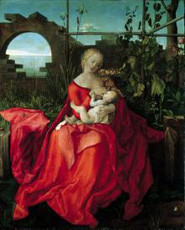“Heaven and Earth: Art from Islamic Lands”, at the Hermitage Rooms in Somerset House, is a small but beautiful exhibition with a modest sense of missionary purpose. Its contents are drawn principally from the fine Islamic art collections of the State Hermitage Museum. The director of the Hermitage, N.B. Piotrovsky, writes well and poignantly, in his lucid introduction to the exhibition catalogue, about the mutual mistrust and misunderstanding that currently separates the cultures of Islam from those of the West. “An almost hysterical fear of the threat posed by Islam is one result of this non-communication… while, from the other side, comes the Muslim perception of the Western world as intensely and implacably hostile. This exhibition cannot change such entrenched world views but it can perhaps do a little to explain and inspire.” Global peace is unlikely to ensue but “Heaven and Earth” is at least a bright reminder of all those threads of connection – the quest for spiritual enlightenment, the thirst for beauty, the yearning for paradise – that join the Muslim and the Western worlds. Islam is above all a religion of the word and its most influential work of art remains the Koran itself, the poetic text of Mohammad’s “recitation”, forced out of him (as he expressed it) following his mystical embrace with the angel Gabriel on Mount Hira. “He is the One God; God, the Eternal, the Uncaused Cause of all being. He begets not, and neither is he begotten, and there is nothing that could be compared to him.” (Koran 112). Mohammad, like later generations of Orthodox Christians and European Protestants, placed a ban on religious imagery, and the first gallery of “Heaven and Earth” is principally devoted to the attempts of Islamic scribes to convey the transcendent mystery of God in the forms...
Islam is above all a religion of the word and its most influential work of art remains the Koran itself, the poetic text of Mohammad’s “recitation”, forced out of him (as he expressed it) following his mystical embrace with the angel Gabriel on Mount Hira. “He is the One God; God, the Eternal, the Uncaused Cause of all being. He begets not, and neither is he begotten, and there is nothing that could be compared to him.” (Koran 112). Mohammad, like later generations of Orthodox Christians and European Protestants, placed a ban on religious imagery, and the first gallery of “Heaven and Earth” is principally devoted to the attempts of Islamic scribes to convey the transcendent mystery of God in the forms...

Art from Islamic Lands, at the Hermitage Rooms; Durer and the Virgin, at the National Gallery
04-04-2004

